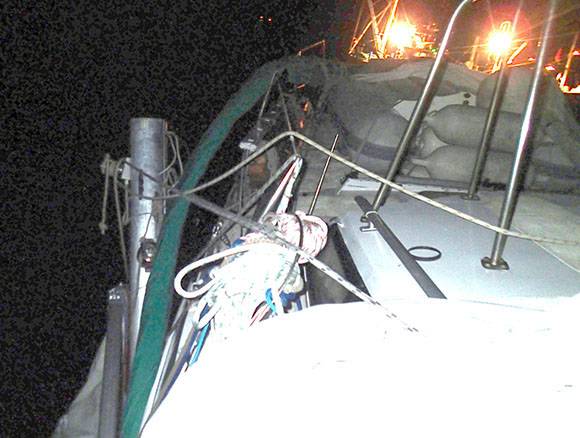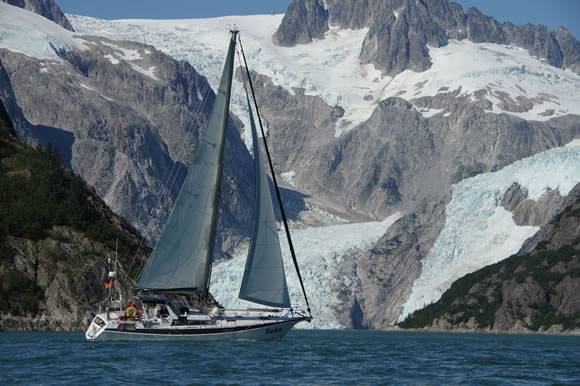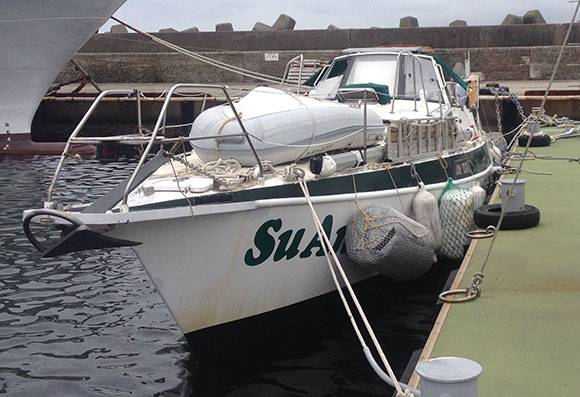Entry Date: 27.05.2015, at 21:45:26 hrs (local)
Katsuura (Japan) - Yokohama (Japan)

Collision with fish trawler - What happened?
| PRID: | 10937 |
|---|---|
| LegID: | 287 |
| LegNo: | 46 |
| Latitude: | N035°18.35' |
| Longitude: | E140°31.08' |
| Day#: | 514 |
| Log (Day): | 1 nm |
| Log (Leg): | 1 nm |
| Log (Total): | 30177 nm |
Our preventer keeps the main sail on port and the spinnaker pole keeps the genoa on starboard.
Japanese waters are highly frequented by all kinds of ships: International cargo ships, local freighters and thousands of fishing boats. A few miles east of us the main shipping line has lots of ship traffic, so we try to stay more close to the shore. But also lots of fishermen are out here to do their work at night. Navigation lights are everywhere.
Since we are quite slow, we have not only our green/red/white navigation light but also a flashing strobe light on top of the mast to warn other ships. Lutz is at the helm and carefully takes his watch. It is difficult to estimate the distance of the other ships at night by those navigation lights.
During our cruise in Japanese waters we often experienced that fishing boots passing by SuAn with very high speed and very close. In order to avoid us they only alter their course to the barest minimum.
At the time of the accident Lutz did not sense any danger when he saw that fishing boat coming closer. He was sure that the vessel is crossing in front of us. Only in the last moment he realizes the wrong perception, starts the engine, turns the wheel and attempts to escape to the port side. But before the engine with full RPM can accelerate SuAn the fishing boot rams with 13 knots into SuAns bow like a homing in torpedo. It rips off our genoa and pole, sheers off the starboard shrouds and stanchions and pulls ropes towards our stern. Our outboard engine is pushed on deck and the radar mast broke at its welded foot, now just hanging sadly over the stern. As all the rig support on starboard is gone the mast with boom, pole and all sails drops to port into the sea, damaging the port reeling. The not used furled up jib is bended heavily over the foredeck. The rig, now upside down in the ocean is just connected with some shrouds and sheets on port and the forestays. The genoa sheet runs diagonal from stern over the solar cells on the cockpit to the white sails of the swimming broken rig in the water. The cockpit with its strong aluminum structure and solar cells on top withstands the forces and Lutz at the helm was not harmed.
The fishing boat stays close by, circles around us, but the communication does not work because of language problems. We are under shock.
Using the handhold VHF radio we send out a Securite warning. No reply. Then we are calling the Japanese Coast Guard (JCG) - No reply. Gabi gets the Satellite Phone out of the emergency grab box and starts to call JCG. Finally after about 30 minutes of calling to two different coast guard stations and long explanations about our previous visited ports they finally understand our situation and position. We are told to remain where we are and arrive at mid night.
Meanwhile, Lutz was working in the mess on deck. The mast was dangerously banging against the hull. He soon realizes that it is impossible to retrieve the rig. With wire cutter, saw and knife he cuts lose all connections between hull and rig and sends it to the bottom of the sea.
Before we start the engine we carefully check for ropes in the water and turn the shaft with the hand. Since there is no unusual resistance we start the engine and put it in gear.
As instructed we follow the JCG patrol boat and at 5 a.m. SuAn is docked at the coast guard pontoon in Katsuura Fishing Port.
We are still under shock and totally exhausted and in three hours JCG will begin with the investigation.






